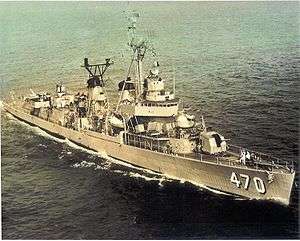Escort destroyer
An Escort Destroyer with United States Navy hull classification symbol DDE was a destroyer (DD) modified for and assigned to a fleet escort role after World War II. These destroyers retained their original hull numbers. Later, in March 1950, the post World War II ASW destroyer (DDK) classification was merged with the DDE classification, resulting in all DDK ships being reclassified as DDE, but again retaining their original hull numbers. On 30 June 1962, the DDE classification was retired, and all DDEs were reclassified as destroyers (DD).[1] Escort destroyers should not be confused with the cheaper, slower, less capable, and more lightly armed World War II destroyer escorts

Concept
Following the outbreak of World War II, the Royal Navy had inadequate numbers of warships suitable for escort of trade convoys. While more modern destroyers were assigned to screen capital ships, destroyers built during World War I were modified to serve as trade convoy escorts. Four V and W-class destroyers were re-armed with modern anti-aircraft and anti-submarine weapons. Additional V & W destroyers received simpler modifications as shipyard resources became taxed by other wartime needs. The quarterdeck gun was removed to increase depth charge stowage, and the after bank of torpedo tubes was replaced by a 3-inch (76 mm) anti-aircraft gun for escort of convoys in European coastal waters. Destroyers escorting trans-Atlantic convoys also replaced the forecastle gun with hedgehog, removed all torpedo tubes to improve seaworthiness, and replaced one boiler with additional fuel storage to increase range. Similar modifications were made to former United States destroyers obtained through the Destroyers for Bases Agreement.[2] Anticipating a possible need to defend convoys supplying NATO allies, the United States Navy modified older destroyers during the Cold War.
Gearing class
Gearing class conversions were modified by replacing the B position 5"/38 caliber guns (mount 52) with either RUR-4 Weapon Alpha or hedgehog. A second Weapon Alpha was sometimes installed at the aft end of the 01 level above the aft 5"/38 gun mount.[3]
Fletcher class
Fletcher class conversions removed all torpedo tubes and three 5"/38 caliber gun mounts to retain only the main deck mounts fore and aft. A Weapon Alpha replaced the B position gun mount.[4]
Similar modifications were made by the Royal Navy, usually to older, World War I era vessels, to fit them for specific tasks such as convoy work.
See also
References
- ↑ Derdall, Guy; DiGiulian, Tony. "USN Ship Designations". NavWeaps. Retrieved 21 April 2016.
- ↑ Lenton, H.T.; Colledge, J.J. (1968). British and Dominion Warships of World War II. New York: Doubleday and Company. pp. 79&80.
- ↑ Warship Identification Manual. United States Government Publishing Office. 1955. p. 32.
- ↑ Warship Identification Manual. United States Government Publishing Office. 1955. p. 35.